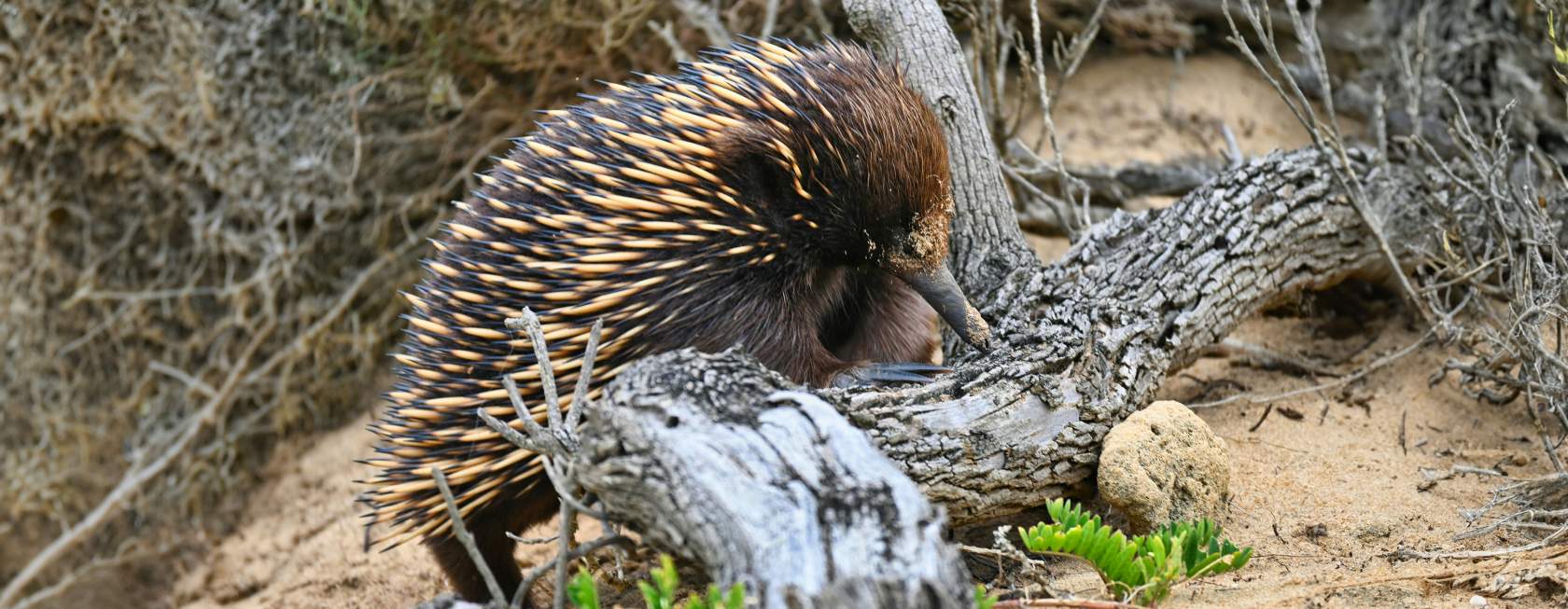
Echidnas (Tachyglossus aculeatus) are a small Australian monotreme known for their distinctive spines. Monotremes are a type of mammal that lays eggs rather than give birth to live young.
Appearance
Echidnas are easily recognisable with their elongated snout and the distinct spines that cover their body.
Adult echidnas can vary in size between 35 to 50cm with their tongue extending up to 18cm. They can weigh upwards of 6kg with males generally reaching a higher weight than females.
Distribution and habitat
Echidnas are found throughout Victoria, including both suburban and regional areas. Echidnas have a large home range, sometimes up to 100 hectares.
Diet
Echidnas are insectivores and enjoy a diet of ants, worms, beetles and termites. They use their snout to help detect either the smell of or the electrical impulse of potential prey.
Behaviour
Echidnas are mostly solitary but may share their home ranges with others. They can cover up to 100 hectares in search of food. They sometimes use drainage culverts to travel under roads but may cross busy roads. Their electroreceptors help them detect electric fields, making them more aware of oncoming cars.
Seasonal activity: You are more likely to see echidnas in your backyard from late June to early September when they are searching for mates or food for their young. During this time, you might even observe an "echidna train," where a group of males follows a female in a line.
Breeding season
Breeding season is from June to September. During this time both male and female echidnas release a scent to attract a mate.
Female echidnas develop a temporary pouch-like area after mating, where they store their egg. The egg hatches after about 10 days, and the baby echidna, called a puggle, stays in the pouch for approximately 8 to ten weeks.
General fun facts
What can you do to help?
The most common echidna reports made to Wildlife Victoria are for those found wandering or in backyards, and those that have been hit by a vehicle.
With increasing development encroaching on their natural habitats, echidnas are commonly sighted in public areas. You might occasionally find an echidna in an enclosed area and wonder how it arrived there. Echidnas are surprisingly skilled climbers; they can scale fences or climb trees, with records showing them reaching up to 2 meters high! It’s best to leave the echidna where you found them unless they appear sick, injured or orphaned.
If you encounter an echidna in your backyard, there is no need to be alarmed. In most cases, if the echidna is not injured, it is simply passing through. The echidna will likely move on within the next 24 hours. Please keep pets indoors until the echidna has moved on and avoid attempting to handle or to dig out an echidna. This may cause undue stress to the animal, potentially resulting in injuries to both the echidna and you.
In Australia, echidnas, like all native wildlife, are protected by law. Therefore, healthy echidnas cannot be relocated. Relocation can interfere with their ability to find their burrows, which is especially critical for females needing to return to care for their young (called puggles!).
If you see an echidna attempting to cross the road, slow down to allow it to pass safely. If it's safe to do so, pull over and turn on your hazard lights to alert other drivers and encourage them to slow down as well. Avoid handling healthy echidnas, even to move them to the other side of the road, as this can disorient them. This is particularly important from October through January, when female echidnas may have dependent puggles in a burrow.
We hope that by increasing your understanding and awareness of our beautiful wildlife, you will feel empowered to manage wildlife situations confidently and in an informed, safe and appropriate manner. For support at any time, please call our 24/7 Emergency Response Service on (03) 8400 7300.
